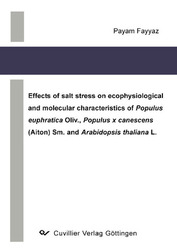| Areas | |
|---|---|
| Serie de libros (96) |
1379
|
| Nachhaltigkeit |
3
|
| Gesundheitswesen |
1
|
| Letra |
2367
|
| Ciencias Naturales |
5407
|
| Matemática | 229 |
| Informática | 319 |
| Física | 980 |
| Química | 1364 |
| Geociencias | 131 |
| Medicina humana | 243 |
| Estomatología | 10 |
| Veterinaria | 108 |
| Farmacia | 147 |
| Biología | 835 |
| Bioquímica, biología molecular, tecnología genética | 121 |
| Biofísica | 25 |
| Nutrición | 45 |
| Agricultura | 1004 |
| Silvicultura | 201 |
| Horticultura | 20 |
| Ecología y conservación de la tierra | 148 |
| Ciencias Ingeniería |
1793
|
| General |
98
|
|
Leitlinien Unfallchirurgie
5. Auflage bestellen |
|
Erweiterte Suche
Effects of salt stress on ecophysiological and molecular characteristics of Populus euphratica Oliv., Populus x canescens (Aiton) Sm. and Arabidopsis thaliana L. (Tienda española)
Payam Fayyaz (Autor)Previo
Indice, Datei (57 KB)
Lectura de prueba, Datei (82 KB)
Salt tolerance is a complex trait that involves biochemical, physiological and
morphological modifications that are regulated at the molecular level. The aim of this work
was to understand the effects of salinity on P. euphratica, a salt tolerant species. For this
purpose ecophysiological and molecular methods were applied and necessary comparisons
were conducted with P. x canescens, a salt sensitive species or A. thaliana, the model plant
for herbaceous species. The present work shows that P. euphratica under salinity is able to protect its plasma membrane and maintaine quantum yield efficiency of PSII.
Molecular analysis showed that the expression levels of two genes were increased in
response to salinity (TIL and SIS) in both P. euphratica (PeuTIL) and P. x canescens
(PcaTIL). These genes were characterized to study their functions with respect to salt
tolerance. In both root and leaf, PeuTIL was up-regulated after salt stress and decreased to the control level within few hours. Comparison of PeuTIL and PcaTIL showed that the transcript level of TIL in P. euphratica was significantly higher than that of its homolog in P. x
canescens both under control conditions and salt stress. It has also been found that the
expression of PeuTIL in leaves was considerably higher than in roots. In silico analysis of
PeuTIL revealed evidence for a transmembrane segment. The homolog segment in AthTIL
exhibited lower hydrophobicity than that of PeuTIL and PcaTIL, respectively.
To obtain evidence for factors controlling gene expression of TILs, the upstream
regions of AthTIL and PtrTIL were searched for cis-acting elements and the results were
compared. Elements related to ABA signalling, early response to dehydration, endosperm
specific expression (DOF-binding site) and seed storage regulation were common and highly present in the upstream regions of both genes. ABA signalling and early response to
dehydration elements were more frequently present in the PtrTIL upstream region suggesting a higher efficiency of transcriptional control in P. trichocarpa than in A. thaliana in response to stress. To characterize the function of TIL in plants, knock-out mutants of its homolog in A. thaliana were investigated. The mutants and controls were subjected to different stress factors. Knock out mutants of AthTIL were more salt sensitive than the wild type but no differences were observed under equivalent osmotic stress induced by PEG. Also different temperatures in a range of 14°C to 34°C did not reveal any differences between knock out mutants of AthTIL and wild type plants. AthTIL knock out mutants showed an early bolting phenotype. Since increased lipid peroxidation induces lipid-derived-signalling leading to bolting in Arabidopsis, it can be speculated that the absence of TIL, may affect plasma membrane lipids and that may induce early-signalling and bolting. However, further investigations need to be done, especially comparing lipid peroxidation in the vegetative stage. PeuSIS is a gene encoding a protein of yet completely unknown functions. The gene was cloned together with its homolog of P. x canescens (PcaSIS) and subjected to loss of function experiments and in silico analysis. Expression studies revealed that PeuSIS was upregulated shortly after salt shock and decreased to the control level within a few hours. There were no differences in gene expression between leaves and roots and also not between P. x canescens and P. euphratica. All together 4 hits for this gene were found in NCBI data bank. All of the SIS genes show a high frequency of serines and display high similarity in the last 50 amino acids out of 157 amino acids. Based on SignalP and Netphos prediction, this protein is localized in chloroplast and has ample phosphorilation sites, which might tie in this protein into the signaling chain. Also the upstream regions of both PtrSIS and AthSIS were searched for putative
transcription factor binding sites that may be involved in controlling gene expression. It was
found that this region is rich of potential transcription factor binding sites for light induced
elements, seed storage protein promoter elements and chloroplast gene expression elements in both species. The upstream region of PtrSIS contains a considerable amount of early response to dehydration, ABA response elements and light responsive elements in
comparison with AtSIS. This study assigns a novel function to TIL by showing that TIL may play a role in salt tolerance in P. euphratica during short term salt adaptation by protecting the plasma membrane.
| ISBN-10 (Impresion) | 386727536X |
| ISBN-13 (Impresion) | 9783867275361 |
| ISBN-13 (E-Book) | 9783736925366 |
| Idioma | Inglés |
| Numero de paginas | 178 |
| Edicion | 1 |
| Volumen | 0 |
| Lugar de publicacion | Göttingen |
| Lugar de la disertacion | Göttingen |
| Fecha de publicacion | 19.02.2008 |
| Clasificacion simple | Tesis doctoral |
| Area |
Silvicultura
|








